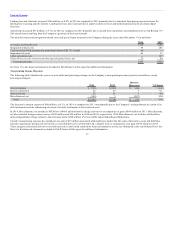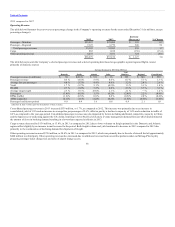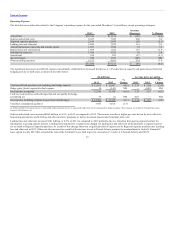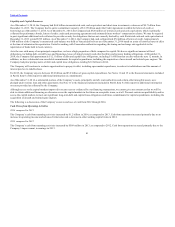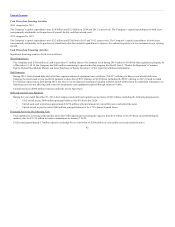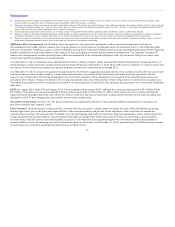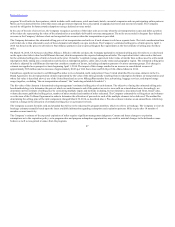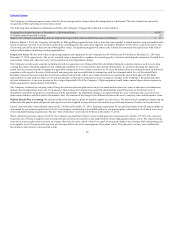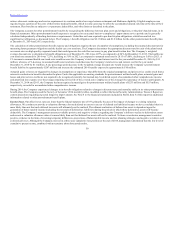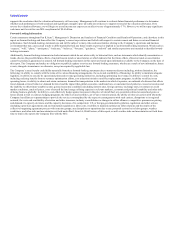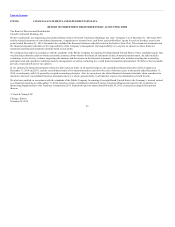United Airlines 2014 Annual Report Download - page 47
Download and view the complete annual report
Please find page 47 of the 2014 United Airlines annual report below. You can navigate through the pages in the report by either clicking on the pages listed below, or by using the keyword search tool below to find specific information within the annual report.
Table of Contents
program. We sell miles to these partners, which include credit card issuers, retail merchants, hotels, car rental companies and our participating airline partners.
Miles can be redeemed for free (other than taxes and government imposed fees), discounted or upgraded air travel and non-travel awards. The Company
records its obligation for future award redemptions using a deferred revenue model.
In the case of the sale of air services, the Company recognizes a portion of the ticket sales as revenue when the air transportation occurs and defers a portion
of the ticket sale representing the value of the related miles as a multiple-deliverable revenue arrangement. The miles are recorded in frequent flyer deferred
revenue on the Company’s balance sheet and recognized into revenue when the transportation is provided.
The Company determines the estimated selling price of air transportation and miles as if each element is sold on a separate basis. The total consideration from
each ticket sale is then allocated to each of these elements individually on a pro rata basis. The Company’s estimated selling price of miles prior to April 1,
2014 was based on the price we sell miles to Star Alliance partners in our reciprocal frequent flyer agreements as the best estimate of selling price for these
miles.
On March 30, 2014, US Airways exited Star Alliance. Effective with the exit date, the Company updated its estimated selling price for miles to a value based
on the equivalent ticket value less fulfillment discount, which incorporates the expected redemption of miles. The equivalent ticket value used as the basis
for the estimated selling price of miles is based on the prior 12 months’ weighted average equivalent ticket value of similar fares as those used to settle award
redemptions while taking into consideration such factors as redemption pattern, cabin class, loyalty status and geographic region. The estimated selling price
of miles is adjusted by a fulfillment discount that considers a number of factors, including redemption patterns of various customer groups. This change in
estimate was applied on a prospective basis beginning April 1, 2014. The impact of this change resulted in an increase in consolidated revenue of
approximately $95 million (and an increase of approximately $0.26 per UAL basic share and $0.24 per UAL diluted share) in 2014.
United has a significant contract to sell MileagePlus miles to its co-branded credit card partner, Chase. United identified five revenue elements in the Co-
Brand Agreement: the air transportation element represented by the value of the mile (generally resulting from its redemption for future air transportation and
whose fair value is described above); use of the United brand and access to MileagePlus member lists; advertising; baggage services; and airport lounge
usage (together, excluding “the air transportation element,” the “marketing-related deliverables”).
The fair value of the elements is determined using management’s estimated selling price of each element. The objective of using the estimated selling price
based methodology is to determine the price at which we would transact a sale if the product or service were sold on a stand-alone basis. Accordingly, we
determine our best estimate of selling price by considering multiple inputs and methods including, but not limited to, discounted cash flows, brand value,
volume discounts, published selling prices, number of miles awarded and number of miles redeemed. The Company estimated the selling prices and volumes
over the term of the Co-Brand Agreement in order to determine the allocation of proceeds to each of the multiple elements to be delivered. The method for
determining the selling price of the mile component changed March 30, 2014, as described above. We also evaluate volumes on an annual basis, which may
result in a change in the allocation of estimated selling price on a prospective basis.
The Company accounts for miles sold and awarded that will never be redeemed by program members, which we refer to as breakage. The Company reviews its
breakage estimates annually based upon the latest available information regarding redemption and expiration patterns. Miles expire after 18 months of
member account inactivity.
The Company’s estimate of the expected expiration of miles requires significant management judgment. Current and future changes to expiration
assumptions or to the expiration policy, or to program rules and program redemption opportunities, may result in material changes to the deferred revenue
balance as well as recognized revenues from the programs.
47


